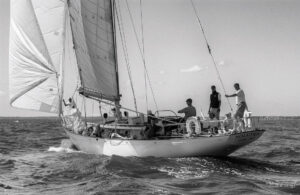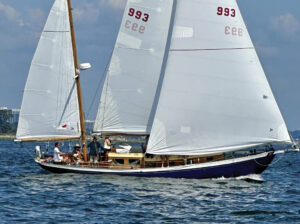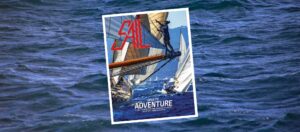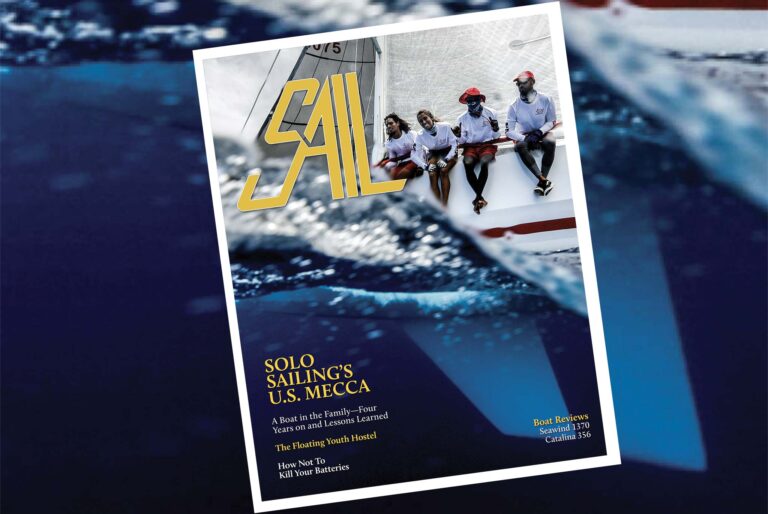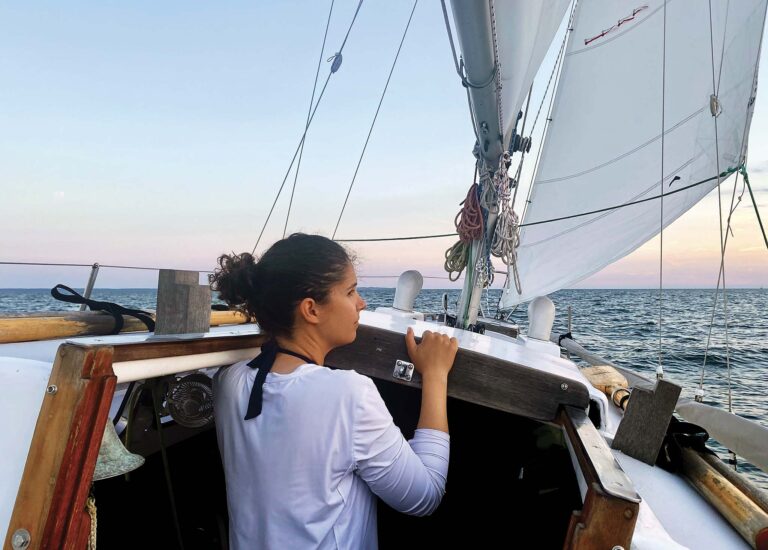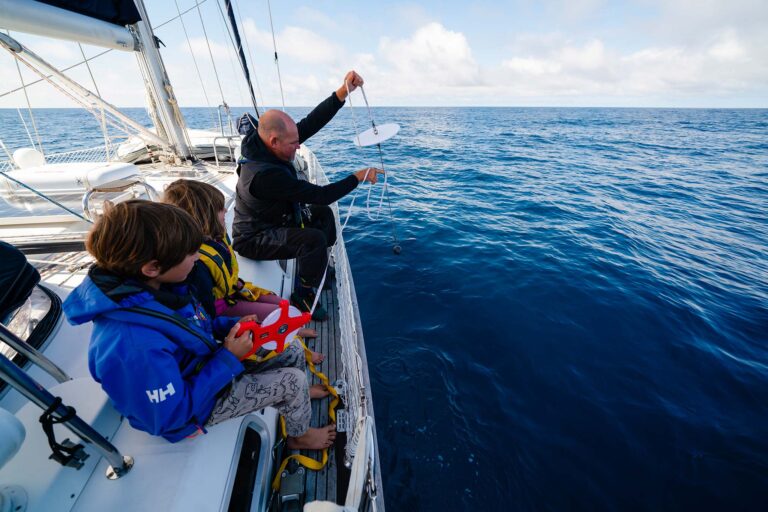
When several members of our Florida sailing club, the West Coast Trailer Sailors Squadron, decided to get together for a group daysail on a recent September morning, I knew I wanted to go along. I’d never sailed at the Dunedin Causeway, and I’m always up for a fun sail on Transmogrifier, my repurposed Thistle. Despite a weather radar showing thunderstorms, they were moving away when we convened, and we had blue skies, a few puffy clouds overhead, a gentle breeze, and pleasant temperatures following the storms.
In the light breeze, I left the beach under full main and jib. I’d acquired Transmogrifier as a derelict hulk, but now with her cockpit decked over and a full-width cabintop, she’s a great beach cruiser, which I’ve dubbed a ThistleCruiser. Originally intended for a crew of three, she is over-canvassed for a solo sailor, making for fast and exciting light air sailing. But her modified self-bailing cockpit makes her self-rescuing, and with her heavily weighted centerboard, she is nearly self-righting. I have modified her rig a bit with a masthead float, a freestanding roller furling jib and three reefs in the main. I knew from our club’s recent capsize clinic that she is hard to capsize and easy to right.
But today was to be an education, and it started shortly after I left the beach. Unfamiliar with the shoals, I found myself playing the centerboard pennant as much as the sheets. The pennant had gathered a couple of half hitches, so I brought her head to wind to sort them out. I thought it would just take a moment…then she tacked, and with the sheets still cleated and my weight to leeward, over she went. While some other club members were a bit concerned, I was mostly embarrassed at my foolish carelessness. I was able to quickly right her and resume sailing.

The wind gradually picked up a bit and Transmogrifier became overpowered. I tried to roll up the jib, but the attachment of the tack to the luff wire failed and prevented furling, so I simply dropped it and stuffed it into the forward anchor well. A bit later I took in the first reef, and she became much more docile while remaining speedy.
The group’s goal was a nearby spoil island. As I got closer to the island, I saw that dark clouds had started approaching from the north and west. A thunderstorm was likely. After watching the sky and considering the options for a few minutes, I decided to return to the launch area. As I headed back, I hailed Tom in his Sea Pearl, and he said the group’s plan was to shelter behind the island if weather came. This seemed an attractive option offering continued sailing and remaining with the others, so I turned and resumed my original course.
It only took a minute or two to realize that I was once again about to make a familiar mistake of trusting others’ judgment over my own. Reversing course yet again, I had a nice broad reach back to the beach and made it safely before the storm arrived. As the dark clouds neared, I got the wet sails off the boat quickly and stowed them in my truck, leaving the boat pulled up on the beach.
Before I could retrieve Transmogrifier, I had to help another club member who was having trouble with their rig. By the time that was squared away, the wind had shifted, gotten gusty, and the first few heavy raindrops were starting to fall. I backed my trailer into the water and got out to retrieve the boat. And that’s when it got interesting, as she wasn’t where I had just left her.
The gusts had pushed her off the beach and she was being blown downwind, along the beach but somewhat divergent. I chased after her, gaining at first, but as I got into thigh-deep water, my progress slowed. I turned and slogged back ashore, sprinted along the beach to get ahead of her, and splashed out towards her, swimming the last bit. At the last moment, I was able to grab the mainsheet that was trailing astern.
I mistakenly thought I had things under control. Standing, I now realized I was in neck-deep water. Between the wind on the boat and a soft bottom below, I couldn’t pull the boat towards shore by walking. I tried pulling her while swimming, which was equally ineffective. After splashing, slogging, sprinting, pulling, and swimming, I was becoming exhausted.

Finally realizing the extent of my predicament, I pulled myself to the boat and clambered aboard, grateful for the handholds I had installed after our capsize clinic. My lifejacket was still on deck, and I put that on first thing, but in the process, I lost overboard my hat and the small handle for the halyard winches.
The boat was rolling dramatically, so I dropped the centerboard, stabilizing her before I made my way forward to the deep anchor well. I have a 4-pound fluke anchor and use half-inch nylon webbing for a rode that I keep on a Cuban reel. I had tied the reel to the anchor with twine. After trying and failing to untie the twine, I remembered the knife attached to my lifejacket and finally cut the twine, freeing the reel. Deploying the anchor, the tape went out so fast I had trouble tying it off to the cleat, but once I did, I again thought—incorrectly—that I had things under control.
As the bow came up into the wind, the boat started heeling dramatically. I had run up onto a shoal and the centerboard was jammed and holding her heeled over. Fortunately, the pennant’s large mechanical advantage enabled me to retract the board despite the force on it. With that done, I was able to sit and catch my breath. The efforts so far had really winded me.
Other members estimated the wind at 40 to 50 knots, although my guess was 25 to 30 in my location. Sitting in the lee of the cabin, I reviewed my situation. I was a couple of hundred yards from shore, had no sails, no motor, no VHF, and my cell phone was on the center console of the truck which, by the way, was still running and in the water nearly up to the axle. Looking around, I saw another boat, a Wayfarer, capsized 100 yards downwind from me with Bill and Sam, her crew, standing in thigh-deep water beside her. Unable to help, I watched and waited, as my situation seemed stable.
And it was stable…until the anchor started to drag. I could see it pulling a mass of weed across a sandy section of bottom. I retrieved it, freed it of a huge mat of accumulated grass, and re-anchored. This time it held well despite the boat sailing back and forth furiously in the gusts. Fortunately there wasn’t much chop since the wind was off the beach.
A channel ran between me and the capsized Wayfarer; I’d been using the channel mark to confirm I was holding position. Eventually a 25-foot center-console fishing boat came running up the channel, apparently in a hurry to get home. They passed the Wayfarer first and then me without slowing. My thoughts were impolite. I pointed to the capsized boat, hoping they would return to assist. And they did, helping Bill and Sam right their boat and towing the swamped Wayfarer back to shore—where they were met by an ambulance crew and fire truck, which had arrived after one of the club members called to report the capsize.

After a bit, the gusty wind abruptly died down to near calm. I pulled up the anchor and paddled towards the closest spot on the beach, making easier progress than I expected, but the ThistleCruiser is easily driven. Once into shallow water, I hopped out and brought her ashore and pulled her along in the shallows the quarter-mile or so back to my truck—which, fortunately, my friends ashore had turned off.
With the trailer already conveniently in the water, retrieval was a breeze. Once we all were sorted, we headed to the tiki bar on the beach for some well deserved refreshments. Just as we arrived, the restaurant lost electrical power and had to shut down, one last slap in the face from this thunderstorm.
The rest of the fleet had weathered the storm without incident by taking shelter in the lee of the spoil island, but they were surprised at the strength of the gusts. It was a day of lessons learned and relearned.

What I Did Wrong
I should have sorted my lines before getting underway; simply uncleating the main would have prevented my initial capsize. Now I know this boat is not nearly impossible to capsize.
The luffwire on the jib is a holdover from her racing class rules, and my shortcut modification did not hold up. I will remove the luff wire and use tapes for head and tack attachments.
I nearly fell into the “follow the crowd” trap. I’ve learned this lesson before and nearly made this common error again.
I didn’t secure the beached boat, obviously my biggest blunder of the day. I thought I had her well up on the beach. I should have put out the anchor to be sure.
Not expecting to need it on a simple daysail, I didn’t have my anchor ready to deploy. The minute I wasted fooling with it might have let me anchor in shallower water, yielding more options.
I had sailed with my cell phone but then left it in the truck while preparing to retrieve the boat. I have a handheld VHF but forgot to bring it on this day. So, while waiting out the storm, I had no means to communicate, which might have been necessary if the situation deteriorated.
What I Did Right
I had practiced capsizing. I knew the boat was easy to right, and I had installed handgrips to make getting aboard easier. While I didn’t really need them after my initial capsize, they were a godsend when I was tired after the chase.
I had added the reef points in the main and knew how to use them, so it was easy to shorten sail when conditions changed.
I kept an eye on the sky. After the morning’s squalls had passed, I remained aware of the possibility of worsening weather.
I put my PFD on. I always wear one when afloat, an inflatable on my big boat and a vest on my daysailer. It reduces the odds of a tragic outcome enormously.
I kept a knife handy. Being able to cut the twine let me deploy the anchor before I had been blown too far away.
I directed the fishing boat to the Wayfarer. With the proliferation of towing services, there seems to be a lessening of the sense of obligation to assist a vessel in distress. The reminder to the center console’s skipper allowed recovery of the Wayfarer and her crew.
As the situation evolved I adapted, solving each new issue as it arose and preventing problems from accumulating and building on each other.

June/July 2024

